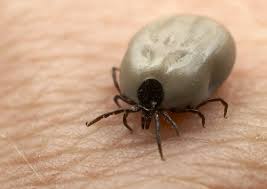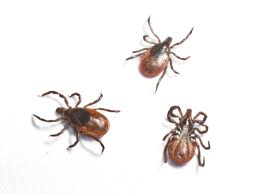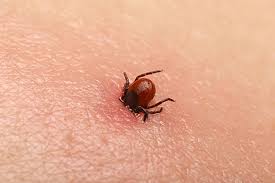(by Kim Tournat)
The number of cases of Lyme disease is increasing rapidly. Last year, more than 800 cases were reported in Canada compared to 128 cases in 2009.
But the numbers may be much higher, Canada’s Public Health Officer Dr. Gregory Taylor said last year. Not all cases are reported to public health authorities even though Lyme disease has been nationally notifiable since 2009.
Officials from the U.S. federal Centers for Disease Control and Prevention, the leading national public health institute of the United States, said this week that about 300,000 people in the United States are diagnosed with Lyme disease each year — about ten times as many as are officially reported.
Dr. Paul Martiquet, medical health officer for the Sunshine Coast, confirmed last week that ticks known to carry the bacteria that cause Lyme disease are present on the Sunshine Coast. He said he is aware of one diagnosed case in the past two years on the Coast.

In British Columbia there are four known species of ticks that carry Borrelia burgdorferi, the bacteria known to cause Lyme disease.
Ticks may not be the only carriers of Lyme disease. New evidence suggests that mosquitos, mites and fleas can also carry and transmit the bacteria.
Researchers on Vancouver Island have recently identified a new strain of Lyme disease in southwestern British Columbia. The infected ticks feed on Eastern cottontail rabbits but can bite people.
Lyme disease can be transmitted from mother to child in the womb. Doctors suggest abstaining from breastfeeding if the mother has Lyme disease. There is also a suspicion the disease can be sexually transmitted.
Borrelia burgdorferi is a spirochete (corkscrew-shaped) microbe that can both swim in the bloodstream and bore into tissue and organs. It’s related to the spirochete bacteria known to cause syphilis. The two diseases share many neurological symptoms, including dementia.
Ticks often carry multiple bacteria, viruses, fungi and protozoans at the same time and can transmit them all in a single bite.
Aside from Lyme disease other common tick-borne diseases include babesiosis, ehrlichiosis, anaplasmosis, relapsing fever, tularemia and Rocky Mountain spotted fever (RMSF).
Some ticks in Canada even carry Powassan virus which can cause an inflammation in the brain, either encephalitis or meningitis. There are no medications to treat Powassan and 10 per cent of cases involving brain infections are fatal.
When diseases are acquired together they are called co-infections. Many Canadian Lyme patients have two or more co-infections.
As the co-infections cause multiple disease symptoms, the diagnosis and treatment of Lyme disease is complex.

A Lyme diagnosis is further complicated by conflicting medical viewpoints.
There are two opposing schools of thought regarding testing, diagnosis and the best treatment for Lyme patients.
This has resulted in two standards of care for Lyme patients.
Canada follows the protocols of IDSA, the Infectious Disease Society of America. These protocols are controversial.
IDSA maintains diagnosis can be easily made in both early and advanced stages by measuring one’s antibody reaction to a possible infection, not the bacterial infection itself.
According to IDSA, Lyme disease is rare and hard to get, but easily treatable. Lyme can be effectively treated by a short course of antibiotics ranging from 10 to 28 days, depending on the stage of illness, the society says.
The International Lyme and Associated Diseases Society (ILADS) disputes IDSA’s position. Its guidelines recommend a very different approach for testing and treatment.
Contrary to IDSA’s assertions, Lyme disease is quite common, ILADS says. The society estimates that there are three times more cases of Lyme disease in Canada than currently reported.
ILADS also disputes the accuracy of the IDSA’s testing protocol. It was meant for research and not as a diagnostic test, ILADS says.
According to ILADS, a negative IDSA test result does not rule out Lyme disease; the IDSA testing system used in Canada causes many false negatives.
Both medical doctors who adhere to ILADS and naturopath doctors use a clinical diagnosis to establish an infection with Lyme disease. They base their diagnosis on the stage of the illness, the medical history, the symptoms and the exposure to ticks.
They also use diagnostic tools such as polymerase chain reaction (PCR), protein antigen and blood cultures testing.
IDSA and ILADS have radically different treatment protocols.
ILADS’ position is that the bacteria are difficult to eradicate due to the multiple ways they survive. The bacteria can form cysts and biofilm, and can become cell wall-deficient, invading the host’s own cells.
ILADS recommends prolonged antibiotic therapy to eradicate persistent infection. Seven hundred peer-reviewed scientific studies of tick-borne diseases support the viewpoint that the bacteria causing Lyme does persist.

Critics have called the ethics of doctors involved in writing the original IDSA treatment guidelines “questionable,” “political” and “scandalous.”
In 2006, Connecticut attorney general Richard Blumenthal called for an investigation of the IDSA guidelines.
Seven doctors in the U.S. involved with updating the 2006 IDSA guidelines have been implicated in a conflict of interest controversy. The history can be found here.
Helke Ferrie, a Canadian anti-IDSA activist: “IDSA’s previous guidelines led to a 2006 antitrust investigation by the Connecticut Attorney General because they were written to benefit the insurance industry and did not reflect current science or patient needs. The authors of these ‘guidelines’ themselves were shown to be owners of vaccine patents (no human vaccines exist to date), receiving million-dollar consultation fees from insurance companies in return for recommendations that would make Lyme disease difficult or impossible to be covered.”
The complete article can be found here.
In 2016, the U.S. National Guidelines Clearinghouse removed the IDSA guidelines from its website.
But for unknown reasons, public health agencies in many countries, including Canada, continue to use the IDSA guidelines.
Medical doctors in Canada fear that the College of Physicians and Surgeons will revoke their medical license if they do not follow the IDSA guidelines.
In early 2017, the Public Health Agency of Canada released a draft framework on Lyme disease initiated by Elizabeth May’s private member’s Bill C-442. It had received unanimous support from the senate in 2014. The purpose of the framework was to provide a comprehensive review of the challenges linked to recognizing, diagnosing, and treating this very serious illness.
The framework was intended to include patient advisory groups and doctors treating Lyme patients. But for unknown reasons, these groups were excluded.
Activists in the Lyme community are continuing to voice concerns about the federal framework which will officially be released this month. A petition to collect signatures for parliament can be found here.
It is an understatement to say there is much more work needed to plan an effective response to Lyme disease in Canada. Dr. Kenneth Liegner is an doctor of internal medicine practicing in Pawling, New York. He has been actively involved in diagnosis and treatment of Lyme disease and related disorders since 1988. This is what he says:
“In the fullness of time, the mainstream handling of chronic Lyme disease will be viewed as one of the most shameful episodes in the history of medicine because elements of academic medicine, elements of government and virtually the entire insurance industry have colluded to deny a disease.”
Thanks Kim, for this informative but very scary article. I have signed the petition.
Thank you for this well written and accurate picture of Lyme disease and the difficulty in getting sufficient treatment.